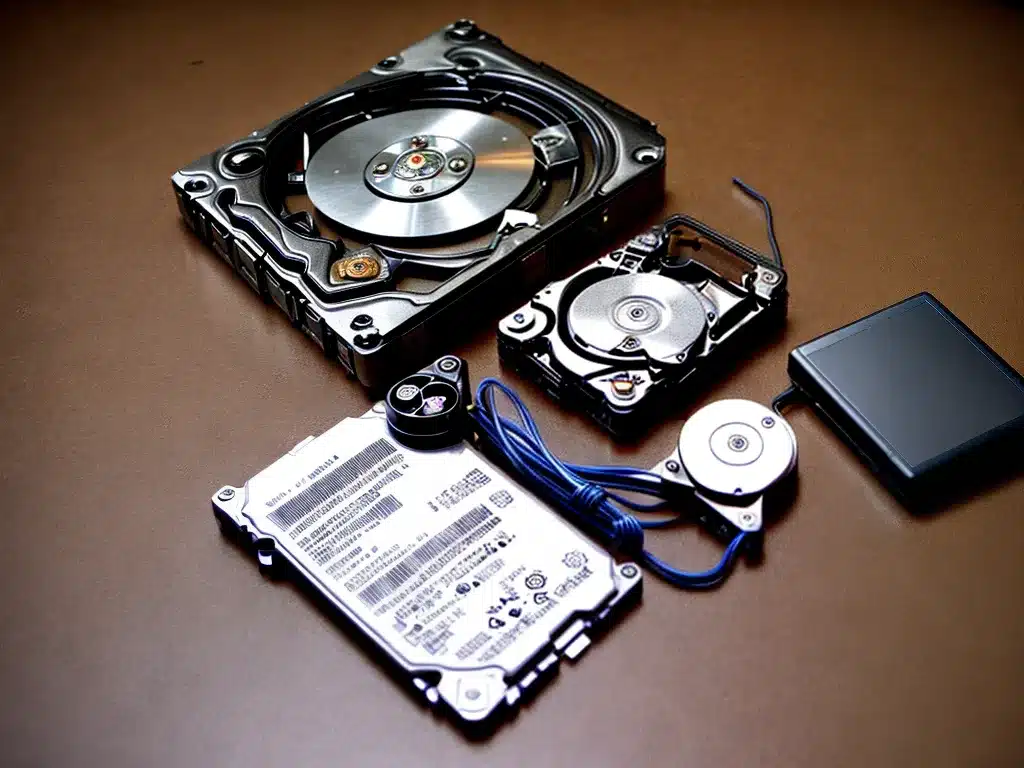Introduction
Losing important files due to a corrupted hard drive can be extremely frustrating. However, in many cases, it is possible to recover lost files and data from a corrupted drive using specialized data recovery software or services. This article provides an in-depth look at the causes of hard drive corruption, the options for file recovery, and step-by-step instructions for recovering files from a corrupted hard drive.
Causes of Hard Drive Corruption
There are several potential causes of hard drive corruption:
Physical Damage
Physical damage to the hard drive, such as from drops, impacts, liquid spills, or exposure to extreme temperatures can lead to corruption and inaccessibility of data. The mechanical components of the drive can fail, preventing access to storage sectors where files are located.
Logical Errors
Issues with the file system, partitions, or other logical components can render the drive corrupted. For example, an unexpected power outage could interrupt a read/write operation, leaving file tables or directories in an inconsistent state.
Malware or Virus Infection
Viruses and other malware like ransomware can intentionally corrupt files or critical boot sectors, making data inaccessible. Ransomware encrypts files and demands payment for decryption.
Bad Sectors
Over time, hard drives can develop bad sectors – areas of the disk that are physically damaged and unable to reliably store data anymore. Attempting to access a bad sector will result in corruption.
File Recovery Options
Data Recovery Software
Specialized data recovery software is engineered to bypass logical errors and extract data from otherwise inaccessible areas of a corrupted drive. Popular recovery software includes:
-
Stellar Data Recovery – Recovers lost files from formatted, corrupted or inaccessible hard drives. Works for RAID recovery too.
-
EaseUS Data Recovery Wizard – Retrieves files lost due to deletion, format, raw, virus attack, system crash etc.
-
Ontrack EasyRecovery – Claims highest recovery rate in industry for formatted, deleted or lost files.
Professional Data Recovery Services
For difficult cases of physical damage, specialized data recovery labs can disassemble the hard drive in a cleanroom and attempt extracting the data using specialized equipment. This is an expensive option, but may work when DIY software fails.
Backup Copy
If you have a backup copy of your files on another drive, cloud storage, or external media, you can simply restore from the backup rather than trying to recover files from the corrupted drive. Preventative backups are extremely valuable in case of data loss events.
Recovering Files from a Corrupted Hard Drive
If your hard drive exhibits corruption, there is a good chance of recovering lost files. Follow these steps:
1. Stop Using the Drive
As soon as you notice the corruption or data loss, stop using the drive. Continuing to write new data could overwrite your missing files.
2. Evaluate the Cause
Try to discern the type of corruption – physical, logical, malware, etc. Understanding the cause will inform the recovery approach.
3. Download Recovery Software
Select data recovery software suited to your type of data loss and download it on a separate healthy computer. Good options include:
-
Stellar Data Recovery – for logical file system errors or corrupted partitions.
-
EaseUS Data Recovery Wizard – for deleted, formatted or virus-infected files.
4. Create a Clone
Before scanning the corrupted drive, create a clone or image file. This is a sector-by-sector copy of the entire drive contents which you can scan for file recovery without risking the original.
5. Recover Files from the Clone
Use the data recovery software to scan the clone for recoverable files. Many tools have filtering to find specific lost file types.
6. Save the Recovered Files
Choose where to save the recovered files – preferably to a healthy external drive. Don’t save back to the corrupted source drive.
Preventing Data Loss
While file recovery is often possible, prevention of data loss is equally important:
-
Backup regularly – Maintain multiple backups of critical data for recovery.
-
Handle drives properly – Don’t expose drives to physical shock, liquids, temperature extremes, etc.
-
Check for bad sectors – Periodically scan drives for bad sectors and relocate data as needed.
-
Use UPS – Use an uninterruptable power supply to avoid data loss from power outages.
-
Install anti-malware – Use security software to detect and block viruses and ransomware.
Conclusion
Recovering lost files from a corrupted hard drive is often possible with the right software and techniques. Specialized data recovery tools can bypass file system errors and extract data from damaged drives in many cases. Following proper precautions to avoid corruption in the first place, combined with diligent backups, offers the best protection against catastrophic data loss.













